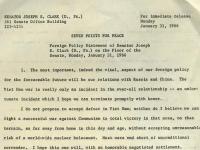This blog was written by Lynn Darby, a Cultural Fieldwork Intern from Temple University’s School of Education.
So what was the Cold War?
A time of geopolitical unrest, the Cold War wasn’t necessarily a war, but was rather an ideological battle between communism and capitalism. At the end of WWII, Germany was divided into the Capitalist West and the Communist East. Controlled by the USSR, East Germany aimed to expand communism's influence into Europe while the US-supported West Germany stood directly opposed to this spread. These two powerhouses were involved in a roughly 43-year long dispute during which the threat of nuclear war loomed as the nations and their ideologies continued to clash. If you’re looking to teach about the Cold War, HSP has just what you need! The Seven Points of Peace: Foreign Policy Statement of Senator Joseph S. Clark provides an intimate look right into how U.S. lawmakers were feeling they should handle this conflict in 1966 as tensions were coming to a head.
How to use it?
This would work well as an anticipatory set of sorts for a lesson pertaining to United States foreign policy during the Cold War. This primary source is an official government document, and allows students to take a look at the political agenda being pushed at the time to keep Russia from consolidating more power. As an exercise, pass out a copy of the document to each student (or allow them to work in pairs or groups) and have them read over the two-page statement. They may draw out key points on their own about the goals and methods of American foreign policy in this statement and discuss in a larger group or groups after that. This would be a great way to transition into a more extensive conversation on foreign policy, the Cold War, or any other political tie-ins relative to the class. Using primary source documents such as "The Seven Points of Peace" is an excellent gateway into the theme of a unit as it adds a sense of gravity to the secondary history textbook, establishing a more active sense of the past for students of the present.
How else?
Teaching about the “Cold War Era” is a very vague term as the era itself lasts decades. Knowing this, this primary source could be used in a compare and contrast style to look at how American foreign policy differed between the beginning of the era and its end in the late 20th century. For this activity, you would need more documents to supplement the lesson, but among them this statement made by Joseph Clark before the Senate would certainly serve as a solid touch point in grasping the tumultuous politics of the Cold War.

